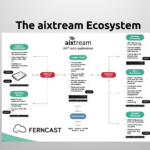As we keep on innovating to revolutionize the way users set up and edit audio connections, whether for classic RTP streams, DVB transcoding, playout of OTT streams or any other audio transmission application, we have developed new PIPE elements. Discover the PIPE Concept in aixtream software and the newest developments!
- Delay – adjustable user-controlled audio delay
It is now possible to force an intended delay in the encoding of an audio output. The delay can be set in milliseconds to any desired value. The main application for this for our current customers can be found in the field of audio-video synchronization. Encoding audio is usually faster than video encoding and so a visible desync would normally result. The Delay element allows the operator to sync the encoding processes by creating an intentional delay, which takes the time for the video encoding into account.
- Loudness Control – adjustable user-controlled audio delay
With Ferncast’s Loudness Control based on R.128 many use cases can benefit from dynamic loudness adjustment. It simplifies workflows for the operators and improves the listener experience noticeably.
- AC-3 – Dolby Digital encoder
aixtream software already supported all commonly used codec algorithms from the very beginning and a few more specific ones were quickly added to the repertoire. This year we added AC-3 (Dolby Digital) to the list to expand our support for DVB use cases, which commonly use AC-3 encoding for their audio content. While MP2 remains popular and an increasing number of broadcasters use AAC, many prefer AC-3. By supporting all three of these, Ferncast ensures we can fully support DVB applications, regardless of the customer’s preferred output.
- ASI – Asynchronous Serial Interface for MPEG TS supported
ASI interfaces can now be used for the output of MPEG TS (including DVB audio). ASI is a technology for the transmission of an MPEG TS via optical or coaxial cable and is therefore commonly used to handle DVB inputs and outputs. This is another feature that shows our commitment to an exhaustive support of all possible DVB use cases. We have integrated support for ASI into our existing DVB over IP element in which an ASI stream can be chosen as an alternative to UDP or RTP streams.









